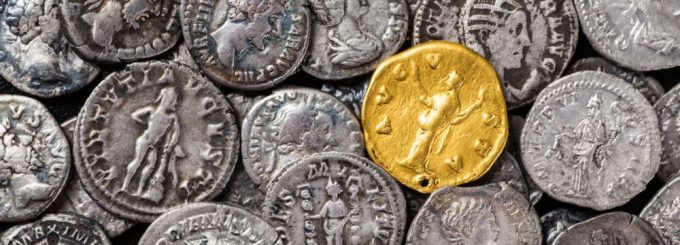Popular Ancient Roman Gold Coins

At its height, the Roman Empire stretched from Great Britain to North Africa and the Levant, and lasted for almost a thousand years. During this time many different gold and silver coins were minted, most of which feature different Emperors. Below are three examples, which are sought after by coin collectors.
Vespasian
Vespasian, also known as Titus Flavius Vespasianus, reigned as emperor from 69 AD to 79 AD. He was the last of the four emperors, who all contested the imperial throne within a single year. Upon emerging victorious, he established the Flavian dynasty which would rule for another twenty seven years. Vespasian grew up in an equestrian household and was the first of his line to achieve the rank of senator. He is best known however for his military prowess, which allowed him to become legate of the Legio II Augusta when Rome invaded Great Britain in 43 AD and during the subjugation of Judea in 66 AD.
As emperor he made a number of reforms to Rome’s financial system which were highly successful and ordered the Flavian Amphitheater constructed. The gold coins were struck after Vespasian’s death and features a shield set before column which is surrounded by a group of branches. It is approximately 7.08 grams and the Twelve Caesars label is present. Vespasian’s laureate head is visible on the obverse side.
Honorius
Honorius, also known as Flavius Honorius Augustus, reigned from 395 AD until 423. He was Emperor Theodosius I’s youngest son with his bride Aelia Flaccilla. Honorius reigned during a tumultuous period, so much so that the nation was sacked for the first time in about eight hundred years. The famous Roman General Stilicho played a key role in stabilizing his reign however, until 408 when he was executed, after which the Roman Empire begin to collapse.
The gold coins bearing his likeness were struck during his reign and is authenticated and graded courtesy of the NGC. On the coin’s obverse side, a military cuirassed bust can be seen; while on the reverse side is an image of a seated Constantinopolis.
Nero
Nero is probably the most infamous emperor on this list. Also known as Nero Claudius Caesar Augustus Germanicus, he reigned from 37 AD to 68 AD and was the final emperor of his family dynasty (Julio-Claudian). His ascension to emperor was approved by the Praetorian Guard but his mother (Agrippina the Younger), was a domineering woman who controlled his life until he finally turned on her and had her executed five years after becoming emperor. Although Rome achieved a number of military successes during his reign, such as the British revolt led by Boudicca, the annexation of the Bosporus region and the start of war between the Jews and Romans, Nero focused primarily on diplomacy, athletic games and the building of theatres. Nero’s gold coin was struck after his death and is about 7.58 grams. It was minted within Rome and is one of the best preserved coins of the era as it received a Very Fine grade from the NGC.


